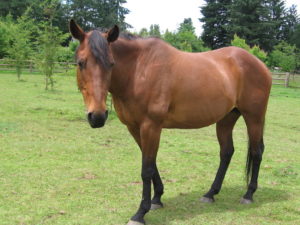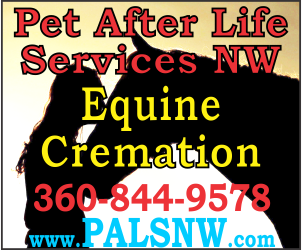How to Calculate Your Horse’s Age and Manage Common Senior Horse Challenges
by Dave Sauter, DVM
 Studies have shown that horses can continue to be serviceable into their older years. One such study found that 63% of older horses still perform some athletic service and 10% are actively competing. With that in mind, what is considered old? Comparing horse age to human age is difficult. Consider the newborn foal and how precocious it is compared to a human. Physically, the foal is like a 2 or 3-year-old person within minutes of birth. There are various ways to compare human years to horse years. Here is one: The first year = 12 human years; second year = add another 7 years; next three years = add 4 years apiece; subsequent years = add 2 ½ years apiece. Using this method, a 7-year-old horse is similar to a 35-year-old human and a 21-one-year old horse is about 71 human years. With advancing years, everything declines. Here are some health problems older horses encounter:
Studies have shown that horses can continue to be serviceable into their older years. One such study found that 63% of older horses still perform some athletic service and 10% are actively competing. With that in mind, what is considered old? Comparing horse age to human age is difficult. Consider the newborn foal and how precocious it is compared to a human. Physically, the foal is like a 2 or 3-year-old person within minutes of birth. There are various ways to compare human years to horse years. Here is one: The first year = 12 human years; second year = add another 7 years; next three years = add 4 years apiece; subsequent years = add 2 ½ years apiece. Using this method, a 7-year-old horse is similar to a 35-year-old human and a 21-one-year old horse is about 71 human years. With advancing years, everything declines. Here are some health problems older horses encounter:
Lameness and musculoskeletal problems (such as arthritis, laminitis, etc.). Have these problems investigated by your veterinarian. Medication and therapeutic trimming & shoeing can help and improve comfort. Osteoarthritis is an expected problem. Regular safe turn out and structured exercise, unless otherwise prohibited, can be very helpful in keeping older horses moving. Weight reduction for the overweight or obese will reduce load on the arthritic joints, improving function and slowing progression of arthritis. Modern joint medications, supplements, and pain medications are also helpful. Tip: Elevating feed for the arthritic horse can help so weight is applied to the front legs while eating.
Colic. “Colic” refers to abdominal pain. During the senior years, the digestive system, like everything else, does not function as well. Cumulative damaging effects of internal parasites, circulatory changes, tumors, and cancer are some of the causes of impaired function of the digestive system in older horses, making colic more common. Management is the key to prevention. Beyond the basics of good feed, dental care, parasite control and farrier care, use extra “TLC” with the aged horse. Change is difficult for all of us, including our horses, and is even more of a disruptive factor for senior horses. Make changes slowly: feed, schedule, and stable mate changes. Older horses also do not regulate their body temperature as well, so provide shelter from harsh weather and blankets when appropriate. Watch out for competition for feed, etc. from other horses. Ensuring a safe and comfortable environment will lead to better digestion and help prevent colic.
Dental problems. At least annual dental work is recommended with use of a full mouth speculum to fully evaluate the inside of the horse’s mouth. Horse teeth continue to erupt throughout their lives and eventually wear out. Uneven wear of the cheek teeth leads to “wave mouth,” severe rims, periodontal disease and many other problems that can impair chewing ability and lead to weight loss, choke and infections. As they get to the end on their reserve crown, the chewing surfaces become “smooth” and unable to grind fiber as well. Eventually teeth wear out and some seniors may need special “soups” prepared daily to provide them with adequate nutrition. Consult your veterinarian about what ingredients will be best for your senior horse.
Weight loss. Many older horses are “hard keepers.” After ruling out the usual suspects (parasites, dental problems, etc.) more challenging possibilities remain such as kidney or liver disease. Blood work and more elaborate diagnostic tests may be indicated. In the end, some individuals may be suffering from malabsorptive disease because of a damaged digestive system that simply cannot process usual foods normally. Treatment will vary with diagnosis.
Metabolic diseases. Cushing’s Disease and Equine Metabolic Syndrome (EMS) are common senior horse problems and have been covered extensively in other articles.
Respiratory. “Heaves” is a common respiratory disease of older horses. Environmental triggers such as mold and dust cause small airways to constrict and an over-production of mucus which plugs the constricted airway. Moving air through the narrowed pathway becomes increasingly difficult. The increasing extra effort required to move air leads to stronger and larger abdominal muscles, what is commonly referred to as a “heave line.” Treatment is focused on reducing exposure to known triggering factors and medication that relaxes and opens the narrowed airways.
Older horses are highly valued for their skills, ability, temperament and because they are our friends. Special care, beyond the basics, can extend their lives and use.
Published December 2012 Issue

Dave Sauter is a Minnesota native and graduated from the University of Minnesota in 1987. Following graduation he interned at Rood and Riddle Equine Hospital in Lexington, Kentucky. After this internship, he continued to work exclusively with horses for another five years in Kentucky before moving out West and joining Kulshan Veterinary Hospital in Lynden, WA. He is a member of the AAEP, AVMA and the WSVMA. For more information about Kulshan Veterinary Hospital call 360-354-5095 or email [email protected]. www.KulshanVet.com






